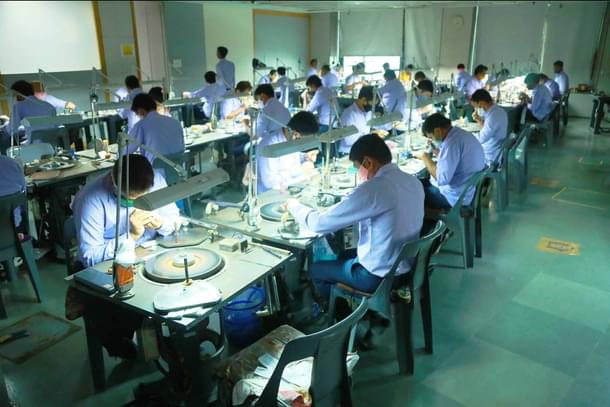Business
Why Has India’s Diamond Business Lost Its Shine?
Business Briefs
May 24, 2023, 05:03 PM | Updated May 25, 2023, 11:31 AM IST
Save & read from anywhere!
Bookmark stories for easy access on any device or the Swarajya app.


Surat, the diamond capital of India, has seen a slowdown in the diamond business due to lower demand from markets like China and the United States of America (USA).
Surat processes 80-90 per cent of the world’s diamonds by some estimates. The decline in exports is a sign that the global demand for diamonds is lower as consumers shift away from discretionary spending.
India’s gems and jewellery exports fell from Rs 1.82 lakh crore in the financial year 2022 (FY22) to Rs 1.76 lakh crore in the financial year 2023 (FY23).
A decline in demand for polished diamonds has pushed prices lower for the industry, along with lower volumes being processed.
Worker unions have claimed that companies are laying off staff as utilization falls to 65 per cent levels. Some players have extended their summer vacations to avoid the lull period. According to the workers’ union, 20,000 people have been laid off.
The industry, estimated to support 8 lakh workers, is also troubled by the high input cost of rough diamonds versus the lower price of polished diamonds.
The low demand for polished diamonds is passing on to the diamond miners. Diamond-producing companies like DeBeers and Petra Diamonds now report softer prices and lower volumes for their diamonds. Petra even withheld diamonds during its last auction as prices offered by buyers were too low.
For a long time, the luxury goods sector had been immune to global issues such as the Russia-Ukraine war and the pandemic.
The sharp divergence between demand for mass-market items and luxury items showed the increasing gap between the rich and the poor. Nevertheless, the luxury goods sector, which had seen strong growth even after the pandemic, appears to be slowing down finally.
Analysts have the growth expectations of LVMH and Hermes International, especially over growth concerns in the USA. The slowdown in luxury goods could hurt the demand for diamonds further.
Another issue the diamond industry faces is the sanctions placed on Russian exports.
Russia’s Alrosa is one of the largest diamond miners in the world and supplies nearly a third of the rough diamonds imported into India. The Russian import into India was cut in half since sanctions were imposed on imports from Russia.
In addition, governments have begun pressuring Belgium to take action against diamonds sourced from Russia. Antwerp in Belgium is the world's diamond capital, with a vast portion of the global diamond trade occurring in Antwerp.
In recent meetings, the governments have warned Indian merchants that the rules would be tightened for diamonds imported from Russia. These could even ban the routing of diamonds through other countries into India, which is a method used by several Indian diamond companies.
Blood diamonds are diamonds mined in conflict zones or by inhuman means. The money from these diamonds is used to finance wars or insurgencies. As a result, over the years, there have been efforts to curb the sales of blood diamonds or conflict diamonds through various means.
Countries opposing the Russian invasion of Ukraine would like to cut off the large sums of money Russia makes from diamond sales. Yet, it is difficult to truly trace a diamond’s journey from the mine to the consumer.
Under the Kimberly Process, a diamond receives a certification of its point of production at the origin. However, as it travels to other places, it gets mixed up with diamonds from other origins, making it difficult to know which location the diamond really came from. As a result, tracking a diamond after it gets polished and cut is a difficult task for governments. If there is a serious ban on Russian diamonds, the lack of supply could push prices up when demand is already sluggish – another possible risk for traders.





